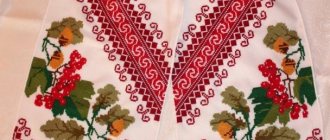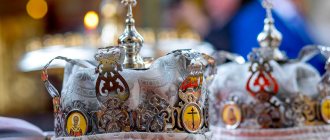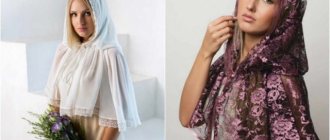Who, how and when can get married
The wedding does not have to be tied to the official wedding date. It can be carried out even after several years, if the young people need this time to prepare for spiritual unity. The key condition, without which no one can get married in any church today, is the presence of a marriage certificate. Both spouses must be baptized according to Orthodox traditions.
| The bride must be 16 years old at the time of the wedding, and the groom must be 18 years old. Many couples have an unreasonable fear that they will be rejected if the bride is already pregnant, but there is no need to worry. The main condition is that children must be born after the wedding. The Orthodox Church prohibits weddings between relatives, atheists and the unbaptized. Also, the ceremony will be denied if the bride or groom has already been married three times. In some cases, a wedding is possible without parental blessing; in this case, the marriage is blessed by the confessor. A wedding is a serious step for believers, much more serious than the official registration of marriage. For this reason, you can postpone the wedding even for several years. This ritual can be performed on Wednesday, Friday, Sunday or Monday, at any time, except for important church holidays and the main fasts: Nativity, Great, Petrov and Assumption. | Photo by Zoya Vanyukova |
Even if you are sure that a wedding is not prohibited on a particular day, do not be lazy to go to the priest and discuss the date with him. Another point that must not be forgotten is that a woman should not participate in the sacraments during her period. This factor should also be taken into account when planning your wedding date.
Towels. A wedding towel for the feet of the newlyweds. Beliefs, useful tips
One of the powerful symbols of wedding ceremonies is the wedding towel. At engagements, matchmaking, and weddings, as a rule, various towels are used, and there is far from one of them - there can be up to four to six, and the Slavs could even have up to 40 of them at ceremonies (from matchmaking to the wedding itself, + they were necessarily used for birth of children).
In this blog we will talk about the towel under the feet, that is, the towel that witnesses during the ceremony lay under the feet of the newlyweds, on which they stand. Everyone knows the sign that whoever steps first on the towel in the registry office - the bride or groom - will be the head of the family.
It is believed that whatever the towel, such will be the life of the young. Therefore, the choice and purchase of a towel must be taken responsibly.
The length, color, richness of the design, symbolism, and density of the towel are important.
The towel must be long , the longer it is, the longer the married couple’s life together. This is why short towels are not in demand.
The towel itself is white , a symbol of purity, honesty, sincerity and trust. The Slavs even had towels that were embroidered with white thread - for a bright union; now such towels are rare, but they are on sale.
Embroidery is usually red - the color of love, passion, joy and happiness. Other colors may be present - blue, cyan, green.
The drawing should be interesting, beautiful, rich. It is believed that a modest and poor drawing will bring everyday life, routine and, ultimately, a cooling of feelings into the life of a young family, that everything in life will be gray, lacking colors, positive emotions, and celebration.
I know one family; they got married during difficult times in the country and did not attach much importance to the choice of a towel. By type: you need to bring something, and we’ll bring it. Further, when years passed, the wife noticed that the design was gray and modest, the towel itself was small and gray. The marriage lasted for a long time, but for both spouses it was a boring affair; the wife often complained that there was no emotion, romance, or beauty in the relationship.
The towel is especially valuable if the bride herself embroidered it and, when stitching it, “put” positive wishes for her future family life into the loops: well-being, prosperity, understanding, love, care, the birth of desired and healthy children, etc. It is believed that the bride must embroider the towel herself; even her blood relatives and closest people should not help her. If there was help of this kind, then it was a bad omen: a symbol that relatives would interfere in the relationship with the husband for the worse, or even worse - a third person might appear in the couple - a rival, a mistress, another woman.
In terms of the pattern of the towel, opinions differ. Very often wedding towels depict wedding symbols - doves, rings, wishes (Bread and Salt, Advice and Love, etc.), and such towels are in great demand. And our ancestors believed that such drawings should not exist. The young people stand on the towel with their feet and symbolically trample the drawing, darkening their future happiness. More neutral designs were considered more suitable - either images of vegetation (viburnum, grapes, flowers) or geometric embroidery.
Grapes are a symbol of prosperity at home, fertility of home and family, health;
Kalina - happiness, love, passion;
Flowers - love, beauty, fidelity, romanticism, tenderness, richness of life;
Drawings of branches and parts of trees could also appear - a symbol of clan, strong connection, stability, male reliability and strength.
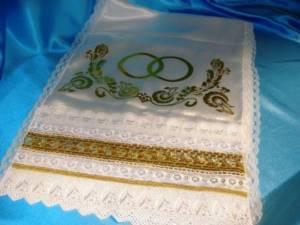
Our ancestors believed that the design on towels is very important and can also have a protective function, be a talisman for a young family both during the ceremony itself, where the young people could be envied and jinxed, and during family life.
It is believed that the towel, which is passed down from generation to generation, especially through the female line, is especially valuable, under the important condition that all women of the family have happy marriages. Then the towel will bring happiness to the bride, if her mother, grandmother, great-grandmother, etc. had happy family unions.
If difficulties, quarrels, or difficulties in relationships occur in the family, then the towel can be sprinkled with holy water and ironed a little. It is believed that this way renewal can come to family life. It especially helps in cases where emotions and feelings have faded somewhat, and intimate life has ceased to be interesting and rich.
After the ceremony, the towel is kept in a secluded place in the house; it is advisable not to show it to strangers.
Interesting fact: The Slavs had towels, the designs on both sides of which were different, because on the groom’s side there was the male side of the towel and male symbols (it could be tree branches, leaves), on the bride’s side there was the female side (flowers).
The bride could embroider the female edge of the towel in advance of meeting her lover. The men's edge was completed after the engagement, when it came to the wedding. Doing this was previously considered a bad omen. For money, wealth in the family and home, money is placed under the towel for the ceremony, then it is given to the young for safekeeping. This money cannot be spent.
Preparation for the wedding
First of all, we are talking about spiritual preparation. Young people must go to confession, take communion, and also pray and fast for 3 days. Also, for several days, those getting married must refrain from any carnal relations, even if they have been together for many years.
It is important to get married in the church where the newlyweds feel most comfortable. No one will judge you if you visit several churches before you decide. And it doesn’t matter whether it’s a big sparkling cathedral or a modest church on the outskirts - the holiness of the ritual will not decrease. It is also worth meeting and communicating with the priest who will conduct the ceremony. It is important that this communication is pleasant for both newlyweds. Guarantors should also be selected in advance. They must be baptized. You also cannot take a divorced couple or common-law partners as guarantors. Guarantors should become spiritual mentors of the married couple, so it is not customary to choose young people who know little about family life for this role. It is better if they are experienced people who have already gone through many problems and know how to solve them.
Wedding clothes
The bride should wear a wedding dress without a deep neckline, covering her knees and, preferably, her shoulders, light but not bright. Full-length gloves, capes and shawls covering the neckline and shoulders are welcome. The head should be covered, but taking into account the fact that you will need to wear a wedding crown (the hairstyle should also take this moment into account), i.e. the hat will be out of place. Also, you should not wear a very fluffy veil, as proximity to burning candles can be dangerous. If the bride has an open dress, the optimal headdress would be a large silk or lace stole or cape that covers the shoulders and neckline. If the dress has sleeves and a modest shallow neckline, you can get by with a beautiful scarf or scarf.
Makeup should be modest. You can line your eyes, but painting your lips is strictly forbidden, since the bride will have to kiss the icon. There are no special requirements for shoes, so you should choose something neat and comfortable. It is better not to take risks with new shoes or high heels, because you will have to stand for a long time.
Any formal suit will suit the groom. There are no special requirements, the main thing is not to come in casual or frivolous clothes. Guests should also dress as strictly as possible: women - in closed clothes with their heads covered, men - in suits without a headdress.
All participants in the ceremony must wear their crosses.
Wedding supplies
Each church has its own peculiarities when it comes to weddings and, accordingly, the list of necessary accessories may vary. We provide the most complete list, and you can check with the priest which of these you really need:
- Passports and marriage certificate
- Wedding rings. They should be given to the priest in advance for consecration. Previously, the wife's ring was silver and the husband's ring was gold. For modern weddings, as a rule, they buy identical rings, giving preference to modest options. You can also use wedding rings that were exchanged at the registry office.
- Wedding candles. It is customary to buy them in the temple where the wedding will take place. After the sacrament, they are kept for life, and in moments of family difficulties they are lit, warming the soul and heart. If guests are present at the wedding, they also need to buy and light candles.
- Pectoral crosses for newlyweds and guests (must hang on the neck).
- Paired Icons of the Savior and the Virgin Mary. According to tradition, they are inherited or given by parents. You can also use those that are already in the house. If you don’t have it, you can purchase new icons in the same temple or church shop
- Red church wine. Traditionally, they buy red fortified wines “Cahors” or “Sherry”.
- Wedding loaf on a hospitable towel. It will be necessary if the parents of the couple who are getting married will be present at the sacrament, who, according to tradition, will greet you with bread and salt after the wedding. Sometimes the loaf is left in the church.
- The wedding towel (foot), on which the newlyweds will stand during the wedding. From time immemorial, towels made of bleached linen were considered the best, symbolizing the long and bright road that the newlyweds will walk together. The tradition of today is beautiful ornamental or Orthodox embroidery and lace around the edges of the towel. Often names and the wedding date are also embroidered on the canvas along the edges. And the center of the canvas - the symbolic place of God - must be “clean”.
- Union towel (towel) - during the wedding they will bandage the hands of the newlyweds as a sign of their spiritual unity. Like the foot, the union towel is sewn from white fabric, but thinner and softer, such as blouse linen or cotton, and decorated with lace, wedding or Orthodox patterns.
- Napkins or handkerchiefs for wedding candles. The tradition of covering the hands with a scarf has been around for centuries. But napkins are needed more for practical reasons - so as not to get dirty and burn yourself with wax.
- Napkins for crowns are intended for holding crowns by witnesses during the sacrament. If there are no witnesses, then the crowns are placed on the heads of those getting married and napkins are not needed.
Often a towel and a set of napkins are sold as a set in the form of a ready-made wedding set. On the one hand, buying a wedding set will save the bride and groom from having to purchase all textile wedding accessories separately, selecting them by color and design. On the other hand, the kit also contains unnecessary items.
You can buy almost everything you need for a wedding from us – as a set or individually. For ease of selection, wedding towels, napkins and ring cushions are divided into collections based on embroidery design.
How to embroider a wedding towel with a cross?
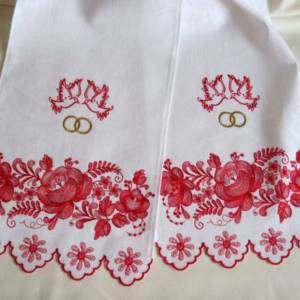
There are a variety of free patterns for cross stitch, among which you can find an option for a towel. The option is easily selected among those available on the Internet. In addition, kits are sold that contain a pattern for embroidering a towel for a wedding loaf or wedding, thread, needle and canvas.
Schemes can be combined with each other
There are schemes of varying complexity, including a certain number of colors. The embroiderer, at her discretion, can choose part of the design from one pattern, and, for example, an ornament from another.
The ornament of towel cross stitch patterns on an icon or wedding can also be symbolic. For example, according to the ornament, you can embroider flowers symbolizing some wish for the young. There are also patterns of diamond patterns, in the form of birds or patterns .
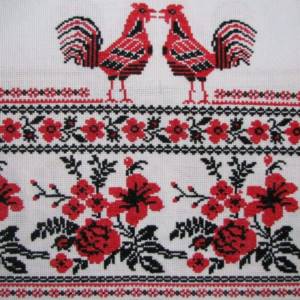
Towel for wedding cross
Previously, a home-woven towel with birch, viburnum, oak trees or other embroidered images was used. Nowadays, for cross stitch, it is most convenient to buy Aida 14 canvas. The edges of the canvas are hemmed by hand. The white field that remains after embroidery is removed. The length of the towel should be at least 140 cm plus the border, and the width 45-50 cm.
When cross stitching, great importance is given to the reverse side. They say that the front side is for people and the back side is for God. To get a perfect back, no knots are used . The thread is secured with a loop.
Wedding ceremony
The priest who marries the newlyweds must call them by their church names. The ritual is held at the entrance to the temple. Blessing the newlyweds, the priest hands them burning candles, which they must keep lit until the end of the ceremony. Then the ceremony continues in the temple premises, where a towel is laid under the feet of the newlyweds.
After reading the required prayers, the priest asks the couple the main questions about whether they are ready to become spouses before God, and whether there are any reasons preventing this union. Answering in the affirmative, they drink wine from the chalice, after which the priest leads them to the icons, after kissing which, the young people become married. Now comes the time for congratulations, but the most important sacrament has already happened.
The meaning of the towel
A wedding towel is an indispensable element during a wedding. It is used during wedding ceremonies and for meeting newlyweds after the registry office. A towel is a decorative embroidered towel, usually made of linen, cross-stitched or satin stitch, and decorated at the bottom with lace or fringe made of the same fabric.
The wedding towel takes place in many Slavic rites, and the name of the matchmaking ritual in various regions is associated with it. It is called giving towels, taking, giving or simply towels. They are an invariable attribute of matchmaking and symbolize the girl’s consent to marriage. They tie it around matchmakers or offer bread on a towel. In some areas, the tradition of the betrothal ceremony has been preserved, during which the bread is covered with a towel and all relatives who take part and the young people put their hands on the towel, and the headman ties them with a symbolic knot, accompanying his actions with special words. After this, the knot is untied, and the matchmakers are tied with towels and given gifts. A young family must keep a wedding towel for the rest of their lives.
Editor's choice: How to live happily - the “formula of happiness” - does it exist?
